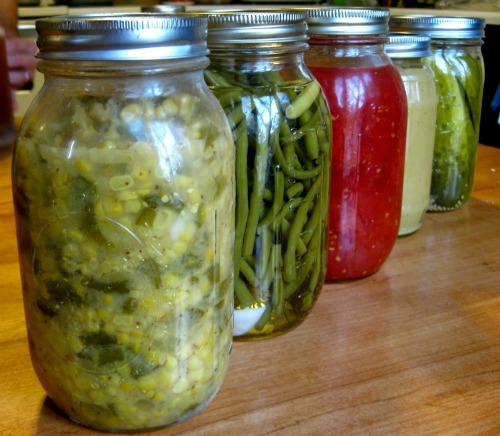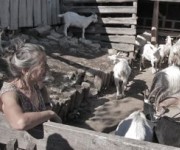Mangalica pigs in Hungary.
Food Studies features the voices of volunteer student bloggers from a variety of different food- and agriculture-related programs at universities around the world. You can explore the full series here.
Over the past few months I’ve visited food producers, large and small, all over Europe. I’ve been behind the scenes on a rice plantation, a coffee roastery, an apple farm, an artisan dairy, a buffalo butcher, and at least a dozen wineries. I’ve tasted some delicious food, but what makes these visits so special is getting to hear how and why the operation exists. In other words: It’s all about the stories. Some producers are keeping traditions alive, and some are starting new ones. Some reveal complicated tales of cultural identity, while others are shrouded in mystery, legend, and scandal. Here are a handful of oral histories I’ve heard in my recent travels.
Olga’s pork broth soup.I remember when Mangalitsa pork was all the rage among fancy chefs and foodies just a few years ago. So I was stoked when I got the chance to visit a Hungarian farm where they raise these curly-hair pigs. They didn’t disappoint. But the better story came from Olga Rendek. When communism spread to Hungary, the State took over the Rendek’s family farm. After the Iron Curtain fell in the early 1990s, her family bought back their land and began farming again. Now she raises Mangalica (the Hungarian spelling) pigs, which are native to Hungary. She sells cured meats from the heritage-breed pigs and a super spicy and addictive paprika paste. The day I visited, she had made a pork-broth soup with tender little dumplings. “In Hungary, we eat soup everyday,” she told me. “We love soup because it keeps us strong in the fields.” I don’t know about the field work, but her pork broth was delicious.
Pendits vineyards in Tokaj, Hungary.Hungary wasn’t on my short list of notable wine-producing countries, but a recent visit to the wine region of Tokaj moved it up to no. 1. The country’s most famous wine is Aszú, also known as Tokaji, or Tokay in the English-speaking world. Winemaker Marta Wille-Baumkauff, owner and winemaker of Pendits Winery, makes Aszú and other wines from the remarkable grapes in the region. She told me that Aszú is known as the “Wine of Kings, King of Wines.” Louis XV actually coined that title, as it was a favorite of European royalty during his time. To make the sweet Aszú, grapes are left on the vine beyond ripening, and if the weather conditions are right, they contract botrytis, a fungus nicknamed “the noble rot.” Aszú was apparently first made when Hungarians were fighting the Ottomans, and the war kept villagers away from their vineyards during harvest time. When the Ottomans retreated for Ramadan, the Hungarians returned to the vineyards and found their grapes rotten. They fermented them anyway and the result, as one legend has it, was the first Aszú. It was a serendipitous event that I’m happy to benefit from hundreds of years later.
Cooperative of Saffron Producers in Kozani, Greece.Photo: Yvonne de ZeeuwI know that saffron is among the world’s most expensive spices, but I’ve never exactly known why. During a visit to the Cooperative of Saffron Producers in Kozani, Greece, I learned about the intensity of production, the scarcity of the spice, and the fraud that runs rampant on the global saffron market. Saffron is actually the stigmas, or reproductive organs, of the Crocus sativus flower. The Cooperative, made up of 1,500 families on 40 communal farms scattered throughout the region, grows the flower and collects the red stigmas by hand for drying. One kilogram of saffron threads requires 150,000 and 200,000 hand-picked flowers grown in an area the size of a football field, so it’s super rare and extremely labor-intensive. In fact, much of the saffron on the market today isn’t true saffron at all, because it includes the petals or stems of crocus — or other flowers completely — dyed crimson. As a consumer, it’s difficult to know what you’re actually buying. The Cooperative and other quality saffron growers rely on designation of origin protection from the European Union, which guarantees it’s the real deal.
The Villnösser Brillenschaf is the oldest breed of sheep in South Tyrol, a region at the base of the Dolomites in Northern Italy. The breed’s name literally translates to “glasses-wearing sheep from Funes Valley,” because the snow-white sheep have black rings around their eyes. Originally bred for its meat, the Villnösser Brillenschaf nearly died off in during the Second World War. (As the story goes, Hitler was a race purist among animals too, and he ordered them to be killed off.) Luckily, just enough remained, the breed was revived, and now it’s raised for artisanal cured meat and wool products, and listed as an endangered species by the E.U.
Enikö the “Goat Whisperer” and her herd.Enikö lives alone in the Hungarian countryside with no running water. Well, she’s not completely alone. She’s got a small herd of goats, one horse, and a few very sweet dogs. She makes raw goat cheese that she sells to restaurants in Budapest. When her goats are pregnant, she sleeps in the barn to be nearby when they’re ready to birth. I’ve dubbed her “The Goat Whisperer.” When asked why she started raising goats, she replied: “Someone owed me money. He didn’t have any, so he gave me a few goats instead. So I learn how to milk them.” Now, it’s obvious, they’re her family.
Sometimes I wonder if the cheese or lamb or even that Tokaji Aszú would be as good without the stories that accompany them. The story gives a sense of place, time, and significance to the making — and eating — of a product, and that’s what makes it memorable.



